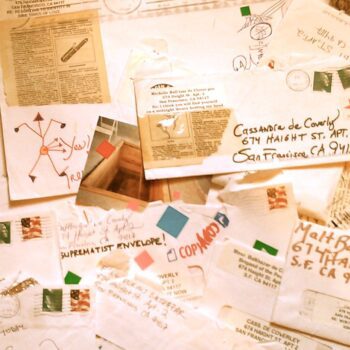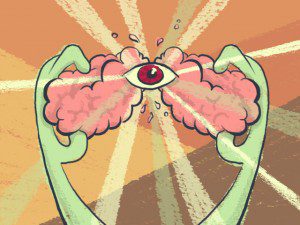
I was in New Orleans in 2004, staying with my girlfriend in a former brothel turned hotel that had termites gnawing the bedposts. Strange hieroglyphic carvings shone on the hardwood floor of our red and cavernous bedroom. I imagined they were codes incised by century-old stiletto heels, a language you could decipher like hobo signs. We spent an evening admiring the poison bottles – gorgeously blue and multi-sided – inside the haunted pharmacy museum. We encountered the famous fake saint of New Orleans, “St. Expedite,” the patron of quick solutions, sailors and schoolboys. Such idol worship thrilled us; what could be made-up could also be made real.
My girlfriend was an artist making sculptures of imaginary organs. I was writing stories about cults and border towns. I had packed a single book for that short trip: the glossy, illustrated Painful but Fabulous: The Lives And Art Of Genesis P-Orridge. In between cemeteries, ghost tours, antique shops and smoky little dive bars full of church pews and stained glass, I read the book with an ever-increasing exhilaration each time I opened it.
In the welter of New Orleans, Painful But Fabulous acted like hormonal propaganda on my impressionable twenty-three year old brain. Through interviews and appreciations, manifestoes and collages, the book tells how Genesis pioneered many strange cultural eruptions, from industrial music to body modification, mail art to performance art, cut-up writing to “chaos magic”, modern primitivism to techno and on and on. He realized early that our human experience was mired in mystery and that art, music, ritual and provocation could make him a medium of this very mystery. Art as an evolving force had consumed his life, and his art changed as psychic and social conditions changed. This ever-questioning, ever-mutable culture existed as a challenge to rigid, consensus culture, or so the story went, even when the latter often co-opted the former.
After reading Painful but Fabulous, I knew I had to become more committed to my own artistic and creative goals. If I wanted to be a full-time writer, I needed discipline as a weapon against the world’s titanic indifference. I had the endless curiosity of a dilettante but not the tenacious work habits of Genesis who once declared, “You should always aim to be as skillful as the most professional of government agencies. The way you live, conceive and market what you do should be as well thought out as a government coup. It’s a campaign, it has nothing to do with art.” What I feared was that I would give up my creative goals simply to meet the biological and social demands of survival and comfort.
Back in San Francisco, quotidian life resumed: we needed to pay rent, find a new roommate, and do mountains of laundry. I went back to work at a construction company, answering phones and printing up reports eight hours a day. I had more or less accepted the inevitable: with my literature degree, a clean, well-lighted office desk was my fate. I realized, at the same time, I was one of thousands of creative types who had come into a similar fate. After all, I was a member of that entitled and naïve generation of over-encouraged children who get liberal arts degrees and expect the world to come leaping into their laps. Or at least that was how the media liked to hyperbolize my own optimism about life.
I was congenial and humorous enough to calm down our clients and meticulous enough to stamp every envelope that required one. Yet the job was monotonous, completely uninspiring and overrun by boorish superiors. Nor was my desk clean or well-lighted; I picked rat droppings off my keyboard every morning and had to wipe sawdust and dead insects off the windows every afternoon. The floor of my office was made of rotting plywood that I often stepped through. Between filth and tedium, I was struggling to justify the work beyond my mediocre paycheck.
I was baffled by the value put on waste in office work. (I would retain this awe when I later worked in brokerage, architecture and law firms, as I was forever implicated in a paper trail that led nowhere but the recycling bin or the shredder.) I was trying to think artistically about my work which to me seemed more practical than ever. How could I redeem these wasted minutes performing wasteful (and wasted) tasks? Even while the work just barely paid my bills, I had to make it work for me on an entirely different level. I knew art could transform so much meaninglessness.
 Taking my cue from Genesis, I started creating “mail art” on the clock, using all the anachronistic machines we made our boring reports with: heat-binders, laminators, giant hole-punchers, etc. These machines existed to churn out lavish and supremely unnecessary technicalities that would be destroyed or filed away forever the moment they arrived. At least my art would reach someone, I told myself – in this case, my girlfriend who would receive the mail at our apartment. My dispatches were mostly typed on the computer and instantly deleted once they were printed up. If I had done my assigned work and spent the rest of my hours sunk in daydreams, there would have been no proof I had actually lived out those on-the-clock minutes. But now I was creating a real paper trail that led to a real person and a real, made-up world that we held in common.
Taking my cue from Genesis, I started creating “mail art” on the clock, using all the anachronistic machines we made our boring reports with: heat-binders, laminators, giant hole-punchers, etc. These machines existed to churn out lavish and supremely unnecessary technicalities that would be destroyed or filed away forever the moment they arrived. At least my art would reach someone, I told myself – in this case, my girlfriend who would receive the mail at our apartment. My dispatches were mostly typed on the computer and instantly deleted once they were printed up. If I had done my assigned work and spent the rest of my hours sunk in daydreams, there would have been no proof I had actually lived out those on-the-clock minutes. But now I was creating a real paper trail that led to a real person and a real, made-up world that we held in common.
I wrote reports of my lunchtime rambles down seedy 6th Street where I often ate rice vermicelli at the counter of the Vietnamese dive Tu Lan while chatting with day-traders or journalists or social workers. Knowing that I would rush back to my work computer and write about it, I peeled my eyes for things I might otherwise disregard: colorful heaps of trash, hidden murals, men playing chess, people leaning out of SRO windows, mangled books on the ground. The anticipation of writing made my half-hour lunches more intriguing. I described the furniture factories, porn shops, donut stores and liquor stores of the South of Market area in minute detail. Often I would find weird, faded flyers on the ground and include them, whole or cut-up, in my letters. A whole ramshackle microcosm resolved itself in my writing, a world of artisans and drifters, day-drinkers and prostitutes, leather daddies and junky bakers, Laundromat custodians and car window smashers. These were the people I wanted to know about, in life and in fiction.
Once, my manager almost caught me with a hastily written pornographic story that I had pulled hot off the shared printer. A lot of what I wrote was sexually explicit and adorned with brazen heirlooms of my sex life with my girlfriend. The landscape of Soma with its used condoms in the alleys and sex shops and leather bars reflected and refracted my own lusts. Nothing was more exciting than injecting the dull workday with the intimate mementoes of my “private” life. But I evaded capture and the result became six month’s worth of daily mail: false reports, found objects, collages, poetic rants and obscenity-laden letters that I mailed to our apartment, ephemera that I’m still mining for inspiration.
The extra half-hour to an hour I devoted every day to my own was one way of dealing with oppressive labor — by infiltrating it with a parallel story. The fact that it was done secretly only enriched the excitement. If something seemed dull and purposeless, you could covertly make it thrilling. Injecting the job with a secondary and secretive purpose also invested the necessary job minutiae (paper clips, stamps, lunch breaks, bathroom breaks) with freshly mysterious significance. Work-life would never be the same because I had developed the imaginative tools to subvert it.
 Imagination is a filter that makes experience more mysterious and illuminating. Art in this sense can defamiliarize things. Then the process is just as important and interesting as the outcome. I’ve had several office jobs since that construction company in which I’ve performed dull, repetitive tasks for a paycheck. But I still believe that wonder (and humor) can be mined from even the most banal work conditions.The whole process I went through in making mail art at work was a good way of awakening what Genesis calls “the third mind”: “by juxtaposing or clashing two minds, objects, phenomena, thoughts, feelings. . .new ideas and inspirations occur.” There are many moments in life when survival and security demand that you take boring things seriously. But you can redeem the dullness and counteract the monotony, sometimes by telling a wildly different story about it.
Imagination is a filter that makes experience more mysterious and illuminating. Art in this sense can defamiliarize things. Then the process is just as important and interesting as the outcome. I’ve had several office jobs since that construction company in which I’ve performed dull, repetitive tasks for a paycheck. But I still believe that wonder (and humor) can be mined from even the most banal work conditions.The whole process I went through in making mail art at work was a good way of awakening what Genesis calls “the third mind”: “by juxtaposing or clashing two minds, objects, phenomena, thoughts, feelings. . .new ideas and inspirations occur.” There are many moments in life when survival and security demand that you take boring things seriously. But you can redeem the dullness and counteract the monotony, sometimes by telling a wildly different story about it.
***
Rumpus original art by Sam Randazzo.




